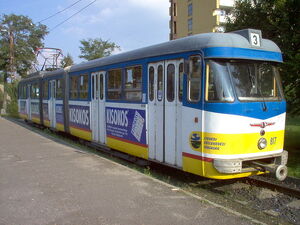| FVV CSM-4 | |
|---|---|

| |
| Length | 22 630 mm |
| Width | 2290 mm |
| Height | 3200 mm |
The FVV CSM-4, nicknamed "Bengal", a Hungarian-made, two-way, articulated tram. The CSM-2 type manufactured successor, initially two-door version of a hand (CSM-3), and later of the inalienability of a side door (in Budapest, they were heavily used) gave a double door system. This was the CSM-4.
Technical Details[]
The vehicle, like its predecessor, the CSM-2, was built on the basis of two középbejáratú ikerkocsi chassis, so a rigid frame construction, which was very beneficial. As in the CSM-2, it also consists of three parts, the middle part belógatott, bogies in the absence of external body keeps. Also 2 +2 axle, which has the middle two, and only a modest acceleration ability. 80 hp engine is able to express.
History[]
The CSM-4 prototype was produced in 1963, the CSM FVV-2 enhanced successor. Budapest, Árpád Kelenfold Füzesi Főműhelyben only 2 years, until 1965, made after the production was moved to Debrecen, where they made them until 1978. The capital was increasingly less need for such a large capacity but slow, difficult to handle, trams and outdated design, manufacture, after it sold most of them into the country (some of them received the decals are in Budapest, but was never marketed in the capital).
Prevalence[]
Budapest[]
Here in 1963, was the street number of 3722's prototype (which was then in Szeged). Until 1983, commuters, pályaszámokon 1201-1236. For a short time had a 64-year line of the Bosnian Füredi Street between the Square and typically in the 60's (u Csörsz-Eastern Railway.) And 68 (Moricz Zs-Mogyoródi roundabout route) traveled routes.
Miskolc[]
In 1970 he published the first two-way tízajtós CSM-4. Until 2004, commuters, pályaszámokon 140-174. Today, only one of the 151's left, it can be seen on special occasions, usually 1 to the line where the 100 pályaszámú would otherwise be unable to go.
Debrecen[]
The first instance was in 1974 in Debrecen rails. 485-492 pályaszámmal between the present day ride. The 485 and 487 pályaszámú cars stopped, their fate is uncertain. January 2010 to 485 and 487 cars pályaszámú dismantled (destroyed).
Traffic cars: 484, 486, 489, 490 *, 491 *, 492 *. Budapest was originally marked with a star traveled to other pályaszámokon.
Szeged[]
Since 1973, Szeged tízajtós tram ride. Pályaszámokon between 801-821. Currently, only the 802, 803, 806, 808, 809, 812, 813, 815, 817, 818, 820, 821 are in the number of cars. It is a 808 teaching purposes while the 820as (prototype of the series) to help the company expects a Budapest villamosbarát. Expected to be restored and the car is shipped.
| Tram types in Hungary | ||
|---|---|---|
| Combino | DÜWAG TW6000 | FAV (kisföldalatti) | FVV CSM–2 | FVV CSM-4 | Ganz csuklós | Hungaroplan | KCSV5 | KCSV6 | KCSV7 | Lohner C3 | Muki | MUV | SGP E1 | Tatra KT4D | Tatra KT8D5 | Tatra T5C5 | Tatra T5C5K | Tatra T6A2 | TM | UV | UV pótkocsi | ||